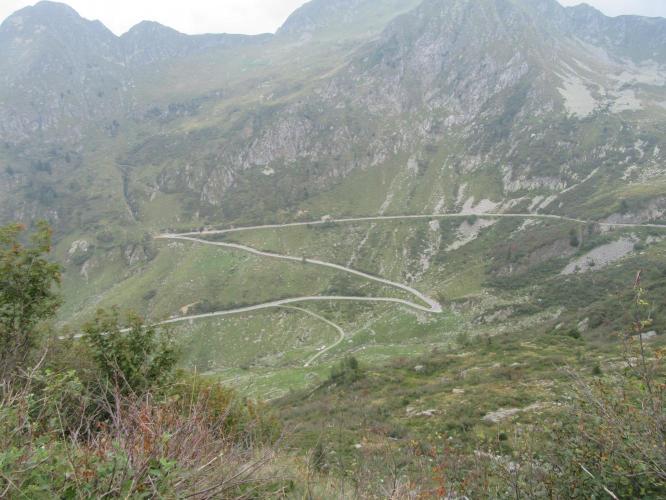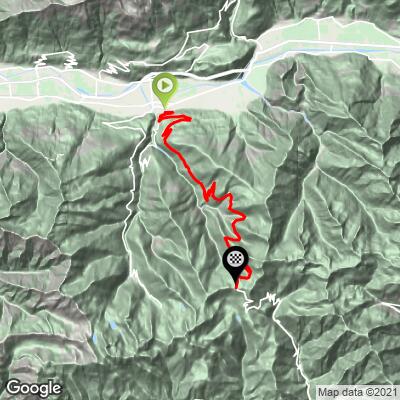Passo San Marco (Morbegno)
Such a beautiful climb, particularly after gradually bending north around mile 4.5 / kilometer 7.2 and travelling along the eastern (left) side of a deep canyon for 3 miles / 4.8 km. There are several big switchbacks along this route, one set while leaving town which offer some views through the trees of Morbegno below, then some very dramatic above-treeline switchbacks that are a spectacular sight when looking back and down on them.
We documented Passo San Marco from Morbegno (northern route) which is 7.8% average grade, 16/25.7 miles/km gaining 5,590’/1,705m. Another challenging climb is San Marco from Olmo Al Brembo - south (12/19 distance, 7% average grade, gaining 4,723’/1,440m; Map , Strava Segement)
While Passo San Marco (Morbegno) is never terribly steep, it is a grinder (in a good way) with a steady grade of 7-9% throughout. The one detraction from this otherwise pristine climb are the many high voltage power lines that run from the summit all the way to Morbengo and are visible most of the climb.
![IMG_9232.JPG]()
![IMG_9214.JPG]()
Strada Procinviale 8 Not one of the Italian climb legends, but worth the effort!
![IMG_9239.JPG]()
![IMG_9248.JPG]()
Views from initial tornanti down to Morbegno Those darn power lines!
![IMG_9279.JPG]()
![IMG_9283.JPG]() Beginning the climb up the canyon mile 5/km 8 (Valle-Campoerbolo)
Beginning the climb up the canyon mile 5/km 8 (Valle-Campoerbolo) ![IMG_9302.JPG]()
![IMG_9301.JPG]()
View north from Albaredo Per San Marco mile/km 6/9.6 View south - towards the pass
![IMG_9353.JPG]()
![IMG_9336.JPG]()
![IMG_9375.JPG]()
![IMG_9411.JPG]()
That’s where we’re headed! Dramatic tornanti last 2.5/4 mile/km
![IMG_9417.JPG]()
![IMG_9426.JPG]()
It’s a wrap!
Giro History
2007 Stage 14 Report (Wikipedia):
26 May 2007 – Cantù to Bergamo, 192 km (119 mi)
The first 85 km (53 mi) of this stage were flat, but two categorized climbs followed. The second-category Passo di San Marco and the third-category La Trinità-Dossena had a 20 km (12 mi) descent between them. Though a flat stretch followed to the finish, it was not likely that any sprinters would be present in the leading group to contest the stage.
The morning breakaway numbered eleven. During the flat stretch before the Passo di San Marco climb, Stefano Garzelli tried to use his team to soften the main field so he could attack and bridge up to the leaders, but team Liquigas, working for race leader Danilo Di Luca, nullified the move.
The group thinned after cresting the climb, leaving only Iván Parra, Paolo Bettini, and Fortunato Baliani just less than two minutes ahead of the pink jersey group, which contained all of the race's overall favorites. Garzelli and teammate Massimo Codol came free of this group on the ascent of La Trinità-Dossena and drew Gilberto Simoni and the powerful Astana duo of Eddy Mazzoleni and Paolo Savoldelli with them. The three breakaway riders were able to stay with them, forming a leading group of seven, after Codol dropped after doing some strenuous pacemaking. They built a 30 second advantage over the pink jersey group, as Liquigas was spent from their earlier effort to keep the race together. They kept their advantage over the other race favorites at that level for most of the stage, contesting a sprint finish among themselves 38 seconds ahead of Di Luca in eighth. Simoni opened the sprint first, with 250 m (820 ft) to go to the finish line, but as is so often the case, the first to go was not the winner. Garzelli passed him up with 60 m (200 ft) left and won his first Giro stage in three years. Simoni moved up from eighth to fifth after the stage, and several time gaps tightened with the day's results.”
1986 - BikeRaceInfo.com - 1986 Giro
“Could Saronni keep his lead in the Alps? Stage fourteen was the first test and after the hilltop finish in Sauze d’Oulx, Visentini gained another 21 seconds on Saronni, while Baronchelli lost a half-minute.
Torriani wanted to cancel the ascent of the San Marco pass, scheduled to be the major climb before the finish at the ski town of Foppolo, saying that with snow on the road it would be a difficult climb. This from the man who engineered stages like the famous Monte Bondone climb in 1956, where dozens of frozen riders, including the maglia rosa, quit in icy misery. LeMond, smelling a fix coming that would lock in Saronni’s lead, got ugly. Arguing it was one of the few chances for him and the other climbers to challenge Saronni, he raised enough stink that Torriani kept the climb. It was good for Torriani and the Giro that the ascent was retained because it was truly memorable.
LeMond and Visentini hit the base of the climb at full gas. The peloton exploded as the contenders scrambled to get up to the flying pair. At the crest it was still LeMond and Visentini at the front, but Baronchelli, Pedro Muñoz, Claudio Corti and Franco Chioccioli had dragged themselves up to the duo. Further back, Saronni and Moser were already two minutes in arrears.
On the ascent to Foppolo, LeMond and Muñoz separated themselves from the other four with the Spaniard winning the stage. Twenty seconds later Visentini came into town, Baronchelli arriving another minute later, Moser and Saronni needing still another minute to arrive. Visentini was in pink and Moser was in high dudgeon. Moser and his director Gianluigi Stanga accused Baronchelli of betraying his teammate Moser by selling his services to Visentini.”

 We've partnered with Sherpa-Map.com to bring you the best route planning tool. With a PRO Membership you can use this climb as a reference when creating your route.
We've partnered with Sherpa-Map.com to bring you the best route planning tool. With a PRO Membership you can use this climb as a reference when creating your route. 

